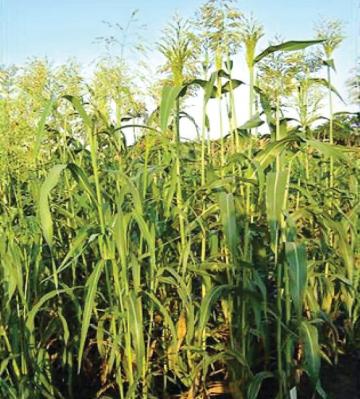
Sorghum or Chari (Sorghum bicolor)
Local names: Hindi: Jowar Tamil: Cholam Telugu: Jonnalu Kannada: Jola Marathi: Jwari
Sorghum as green foliage is very popular in most parts of north India and nearly 2.5 million hactare area is planted during kharif. In summer, under irrigated conditions, multicut sorghum is very popular. It does well under hot and dry climate. It requires well-drained soil and appears susceptible to water logging conditions. Though it can be grown in any type of soil but loam soils have proved to give more yield. The sowing is done in April and August for fodder and June and July for grains in India. When sown for fodder, the seed rate varies from 55-60 kg per hectare and for taking grains from 15-20 kg. It is generally sown mixed with legumes like cowpea and moth in a ratio 2:1. Mostly the sorghum seeds are broadcasted which are then mixed with the soil by various means such as by a cultivator or harrow. Finally the operation is completed by planking.
Sorghum is generally grown as a rainfed crop. If the rainfall is 25-30 cm during the season, no irrigation is required. If it is desired to sow the fodder earlier during the months of April or May, four irrigations are required depending upon the climatic conditions. The fodder is ready for harvest within 70-90 days. The average yield of the fodder varies between 250-450 quintals per hectare. Some varieties show a yield of about 500 quintals per hectare.
Nutritive value
Sorghums are generally non-maintenance type of roughages, containing about 4-5% of protein. Some varieties, however, contain 8-10% of protein like S. almum and Sirsa 20. The total digestible nutrients are 58.0%. However, calcium and phosphorus content is 0.5 and 0.2%, respectively. These varieties constitute a maintenance ration and are thus more profitable to a farmer than the other varieties. Sirsa 20 and Sorghum almum are maintenance type of fodder and proved very useful in the western tract of Uttar Pradesh. Other useful varieties are Rio, Vidisha 68-1 and IGFRI-5.
Deleterious factors
Sorghum (less than 50 cm high) contains cynogenic glycosides. Ruminant animals (cattle and sheep) are more susceptible to prussic acid poisoning than monogastric animals (horses and pigs). The lower pH in the stomach of the monogastric helps to destroy the enzymes that convert cyanogenic glycosides to prussic acid. For prussic acid poisoning to occur, high levels of cyanogenic glycosides and enzymes necessary to metabolise them need to be present. The action of rumen microbes will also metabolise cyanogenic glycosides. Therefore, poisoning is more likely in ruminant animals. Sheep are more resistant to poisoning than cattle due to the different enzyme systems in their fore-stomachs. Hungry animals are also at greater risk as they will normally consume a larger amount of toxic material in a short time.
Signs of poisoning usually occur 15–20 minutes after the toxin is consumed. Death occurs very quickly, approximately 2–3 minutes after the onset of clinical signs in peracute cases, and within 1–2 hours in acute cases. Usually, animals are found dead with no signs observed. The brain and heart are the first to be affected by lack of oxygen, and so the resulting clinical signs prior to death include: breathing difficulties, rapid, weak, irregular pulse, anxiety and restlessness followed by depression, stumbling/staggering, muscle tremors, moaning, dilated pupils, recumbency, bloat, terminal convulsions and bright red mucous membranes. Sorghum grain contains low levels of tannins and α- amylase.
M.P. Chari (Sorghum bicolor)
M.P. Chari is the most important cereal fodder crop grown in summer/ rainy season and gaining more popularity in India because of its high yield. Covering the maximum cultivated area among fodder crops, sorghum is grown in all parts of the country except the cool hilly areas. It has high tolerance to drought and excessive rain fall. There are single, two multicut varieties/ hybrids of sorghum giving one to six cuts per crop producing 50-100 tonnes of green fodder/ hectare. To avoid prussic acid or cyanide toxicity to livestock, the crop should be harvested at about 50% flowering or after irrigation at the preflowering stage. The crop is also useful for hay and silage making.
Important varieties
PC-1, PC-6, PC-23, HC-136, HC-171, PSC-1, Pant Chari-5, Pant Chari-6 and Sorghum Sudan hybrid.
